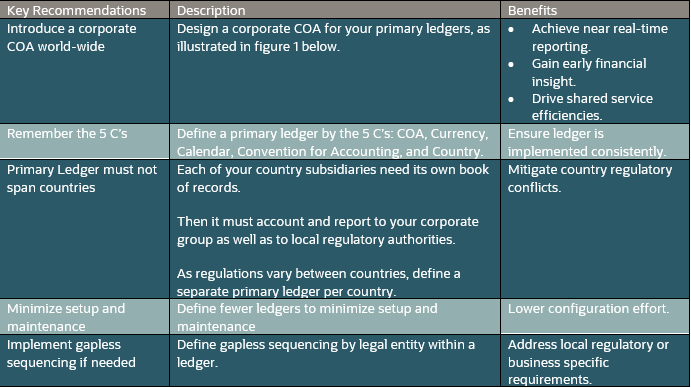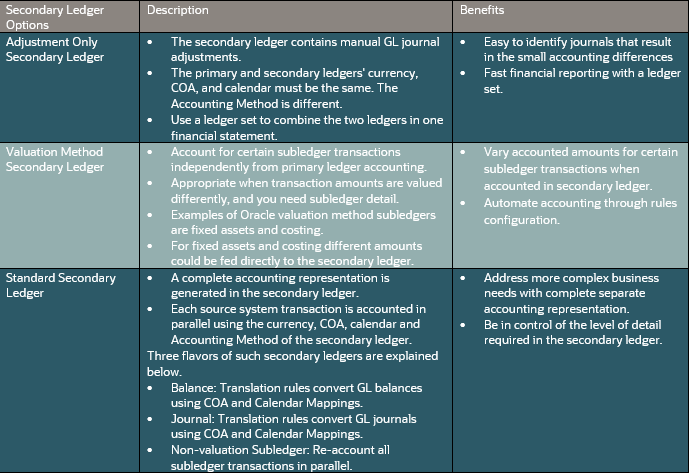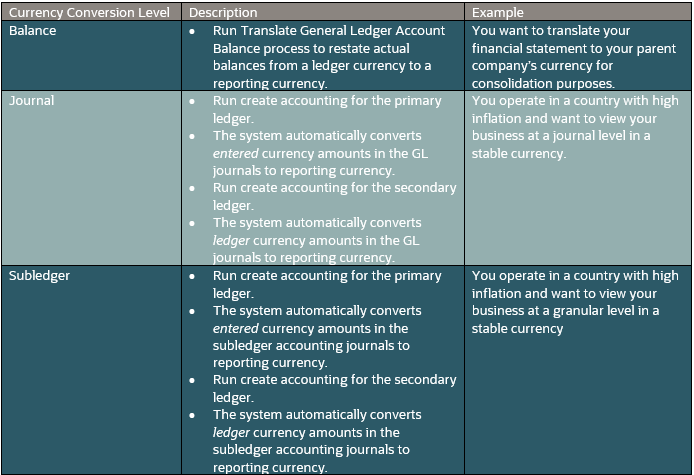Ideally, your finance department wants accounting entries automated to address corporate and local accounting policies.
With Oracle Cloud ERP you can adhere to multiple accounting standards and accounting currencies in parallel. You thereby address local regulatory requirements and corporate accounting policies at the same time.
You define ledger and subledger accounting rules in Oracle Cloud ERP to meet your needs. You’ll find guidance on different ledgers and reporting currency usage below.
Primary Ledger
You configure a primary ledger to secure, manage, and close General Ledger financial balances of the principal bookkeeping entity.


Check out this blog on how to Improve financial insight with a corporate chart of accounts
Secondary Ledgers
You configure ledgers and subledger accounting rules to populate secondary ledgers through one of the three options below. Select one of three options based on the best fit to your business needs.

Reporting Currencies
You maintain accounting records and report in more than one currency through reporting currencies. You can define one or more reporting currencies for a ledger in Oracle Cloud ERP.
Remeasure or translate primary or secondary ledger balances into another currency.
Decide on one of the currency conversion levels: balance, journal, or subledger.

Figure 2 below shows a parent company in the US with subsidiaries in Spain and Canada.

The enterprise structure design decisions are outlined below.
Primary Ledgers
- The Spanish and Canadian subsidiaries report to the parent company in USD and US GAAP.
- Establish a corporate chart of accounts combined with the same corporate calendar and accounting method across the primary ledgers to address US GAAP.
- Nominate the primary ledger currency as the functional currency of each subsidiary, meaning the local country currency.
- Process finance data and view results in screens and reports in primary ledger currency.
Secondary Ledgers
- The Spanish subsidiary must also adhere to regulatory requirements in Spain.
- Define a secondary ledger to help address the regulatory requirements.
- Decide on which option to use to populate the secondary ledger, as explained at start of this blog.
Reporting Currencies
You can see in Figure 2 how subsidiaries report in USD and US GAAP to the parent company. You therefore:
- Associate a reporting currency ledger in USD with the Spanish primary ledger. Apply Balance level translation.
- Associate a reporting currency ledger in USD with the Canadian primary ledger. Apply balance level translation.
Near real-time Consolidation
You get an immediate global financial view of the business with a corporate ledger set. It facilitates GL standardized balances through a corporate chart of accounts, calendar, accounting method and accounting currency.

Figure 3 shows Future Corp Spain and Future Corp Canada reporting currency ledgers grouped into a ledger set with Future Corp US’ primary ledger.
You produce reports quickly based on the ledger set for corporate financial statements and key metrics to your executives.
Conclusion
You can address many accounting standards with Oracle Cloud ERP easily. Design the enterprise structure to automate accounting entries. Define ledger sets to use for key reports to executives. That way, they gain insight early to help drive strategic business decisions.
Gain insight into enterprise structures and ledger design via the Oracle Cloud ERP Enterprise Structures Key Considerations and Best Practices white paper on My Oracle Support here.
Listen to the Oracle Cloud Customer Connect (CCC) event webcast from January 11, 2025, on ERP – Key Elements of Enterprise Structures that You Can’t Miss for Your Global Implementation. You just need to log in to CCC first and then use this direct link here.
